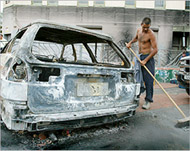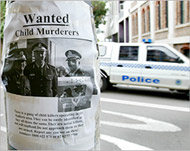Why Australia is not all cuddly koalas
Little J says the best thing about the Redfern race riots is that they were beamed around the world on satellite television.

“They saw us,” he said.
“People around the world, who just think about Australia as a nice place with kangaroos and beaches and sport – now, they know the Aboriginal people are angry.
“And if they think we are going to lay down and do nothing, just because the police tell us to, they have got another thing coming.”
Little J is not his real name. In the wake of Australia’s worst racism riots in a decade, the 16-year-old is hesitant to give his real name when talking to the media.
If they know who you are, he says, they can come and find you.
Refused bail
He points out that the aunt of Thomas Hickey, the 17-year-old whose death in a police pursuit sparked the riot, was arrested and denied bail, leaving her unable to attend her nephew’s funeral.
 |
|
A man sweeps up broken glass |
“Better to keep low,” says Little J.
“That way, if you want to strike at them, they won’t know its coming, and then you can just slip away.”
Little J is a second-generation resident of the Redfern Block, which began life as a utopian experiment in Aboriginal Community Housing in the 1970s, and – after years of failed social policy – is now Australia’s most squalid ghetto.
Here, unemployment and truancy lead to alcoholism and drug addiction. It is Australia’s Harlem, or south central Los Angeles.
Unresolved issue
And no matter how hard white Australians like to pretend that racism does not exist in their country, Redfern is also the telling and undeniable symbol of Australia’s unresolved issue, the status of its indigenous people.
Australia also has a poor reputation globally regarding its treatment of asylum-seekers, who are regularly imprisoned with fewer rights than convicted criminals.
After Hickey impaled himself on a fence and died while fleeing from police on his bicycle, years of frustration erupted in violence, with 100 Molotov-cocktail-throwing Aboriginals facing off against 200 police, 40 of whom were injured.
“It’s a policy of attrition. Look at it – it’s like Sarajevo. There’s an increasing demoralisation and people are giving up hope,” says the Reverend Bill Crews, a respected minister and community figure who has worked in the area for many years.
More than half of the Block residents over 16 are unemployed, and Redfern is Sydney’s long-term drug epicentre, luring not just Aboriginal addicts, but also white middle class users who need a supply.
Drugs trade
“It’s not just Aboriginal people involved here,” says Crews.
“Public servants in their suits on the way to work get off the train at Redfern to buy their hits.”
|
“Public servants in their suits on the way to work get off the train at Redfern to buy their hits” Rev Bill Crews |
After years of fine words and billions of dollars in funding for dedicated Aboriginal programmes, Australia is no closer to solving its racism problem, which still springs from acute economic disadvantage.
The top 10% of Australians are richer than the bottom 50%, and Aboriginals – with an unemployment rate of nearly 40% – are at the very bottom of the scale.
They comprise 20% of the Australian prison population, despite forming only 2% of the wider population. Their life expectancy is 20 years lower than that of other Australians.
These figures have remained the same for decades, despite the efforts of aboriginal leaders, white politicians and even fair-minded police.
Discrimination
For every taxpayer-funded skills development or aboriginal housing programme and for every speech by a politician there are examples of police harassment, legal discrimination and political indifference.
 |
|
Prime Minister John Howard |
While former Prime Minister Paul Keating called out for national “reconciliation” between white and black Australia in a famous speech at a Redfern park in 1993, his conservative successor John Howard refuses to join a national movement to say “sorry” to Aboriginal Australia for two centuries of discrimination, and for events such as the forced separation of Aboriginal children from their families – the so-called stolen generation.
Howard’s reaction to the Redfern riot was to view it as a one-off law and order issue, the result of “family breakdown”.
But according to his political opponents, such a view is naive.
Law and order
“This is not an issue concerning law and order. This is a question of unequal treatment of indigenous people,” says aboriginal leader and Senator Aden Ridgeway.
|
“This is not an issue concerning law and order. This is a question of unequal treatment of indigenous people” Senator Aden Ridgeway,aboriginal leader |
“It’s much more than taking sides with or against the police because I don’t believe that is what people have attempted to do, it’s more a question of drawing attention to unsustainable and discriminatory treatment.”
Only weeks before the Redfern riot, Reconciliation Australia – a national government-supported body created to advise on relations with indigenous Australians – released its annual report, claiming some progress had been made.
“Indigenous affairs is the hardest area of policy-making in the country, but we have an opportunity now to talk, in a more strategic and reasonable way, about issues previously considered out of bounds,” the report said, before going on to describe a “great possibility” ahead now that a “lull” in the reconciliation debate was over.
But in the wake of the riot, this seems like empty rhetoric. Bottle-throwing Aboriginal kids on the streets have once again exposed the myth of Australia as a contented and tolerant society, and if anything, the situation seems worse.
War zone
In Redfern, the plan is to demolish some of the houses to make way for new community Aboriginal housing, but in the meantime the place looks like a war zone.
 |
|
A police car drives past a poster |
“Redfern is dying of a very bad disease. Shops are closing down and every one is moving out. We’re so close to the city, but here it’s dead. I’ve watched it happen,” said long-time resident Auntie Joyce Ingram this week.
But despite the tragedy that is the plight of the Aboriginals, not many Australians give them much sympathy.
A conservative politician in Sydney demanded the Block should be demolished in the wake of the riot, while right-wing Melbourne columnist Andrew Bolt blamed the violence on “drunken thugs and guilt-ridden whites who have poured money into the hands of aboriginal agitators”.
Pointing to inflammatory comments from black leaders at the height of the riot, Bolt claimed that Australians needed to see “how dumb we’ve been to finance the new racism that throws up just such men”.
Racial divide
Bolt’s comments, and their popularity, show how entrenched the racial divide is in Australia.
On the one hand, the Aboriginal community claims their culture has been destroyed and their people starved of opportunity, and on the other middle Australia is resentful of the taxes they pay to fund Aboriginal programmes, and blame Aboriginal Australia for their fate.
Australians like to think of their country as a peaceful one, free of sectarian violence or the American gun culture, which receives such bad publicity there.
|
“If Palestinian kids can fight war tanks with slingshots, our kids can do the same” Lyall Munro, |
But the words of Redfern leader Lyall Munro should sound a warning of how things could degenerate, regardless of how many police are on the street.
“If Palestinian kids can fight war tanks with slingshots, our kids can do the same,” he reportedly said at the height of the riot.
“Let’s get it on,” some of the crowd reportedly yelled back.
Little J, the 16-year-old Redfern youth, is ready for it to happen again.
“No worries brother, I’ll be there again,” he says.
“We’ve got no respect and nothing to lose. I’ll go down fighting, no problem.”